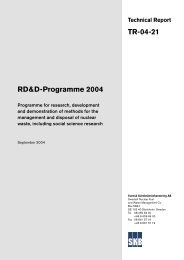Read/Download - SKB
Read/Download - SKB
Read/Download - SKB
- No tags were found...
You also want an ePaper? Increase the reach of your titles
YUMPU automatically turns print PDFs into web optimized ePapers that Google loves.
However, borehole measurements in KFM06C continued to be problematic. During the lastplanned borehole survey before installation of monitoring equipment, the POSIVA differenceflow logging, the probe got stuck in the lower slim part of the transition cone. A sequenceof restoring activities had to be undertaken before the accessibility of the borehole was fullyrestored. These measures are summarized in Table 4-2.The upper and lower sections of the transition cone are joined together with bolts through theflanges. When installing the transition cone, the flange is resting on the bottom of the widerpercussion drilled part of the telescopic borehole. It is believed that the core drilled part of thetelescopic borehole was not exactly centered at the bottom of the percussion drilled borehole,and that this caused a bending of the slim part of the transition cone, which may have been thereason for the difficulties for some probes (those with a large diameter) to pass trough the cone.Table 4-2. Different activities when the accessibility of borehole KFM06C was restored.Date Exchanged part Comments2005-12-01 to 2005-12-05 New lower slim transition cone tube Installed with a percussion drill rig2005-12-20 to 2005-12-22 New transition cone Installed with a percussion drill rig2006-01-24 to 2006-02-01 Smooth-polishing of the inside ofthe transition conePerformed with a percussion drill rig2006-02-13 to 2006-02-22 Decreased diameter of the transitioncone flangeInstalled with an Atlas Copco B20 coredrill rig. To rinse the borehole bottom frommetal junk, a short drill core was recovered,entailing that the borehole was extended to1,000.91 m length28
















